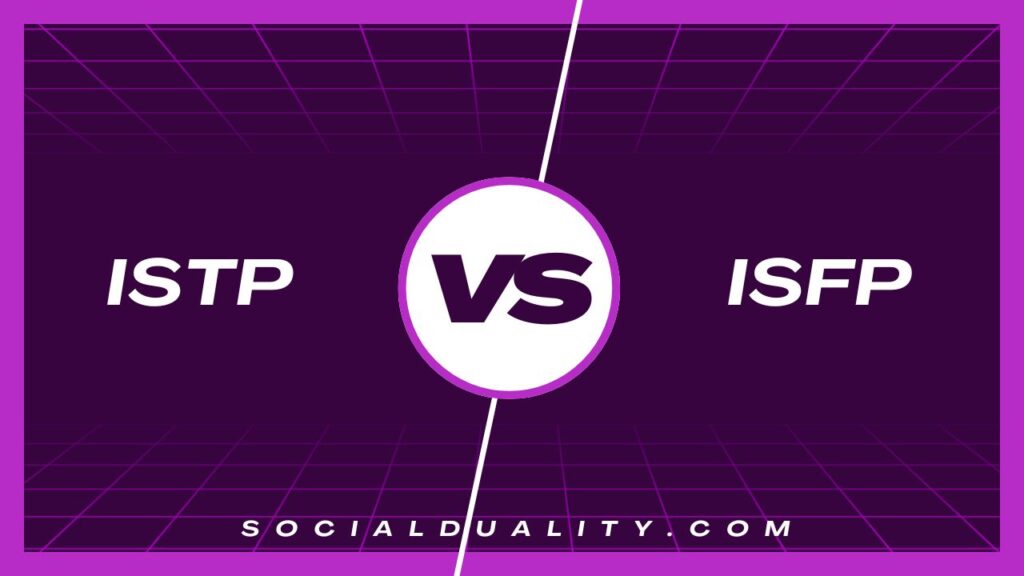Exploring the unique personality traits of ISTPs and ISFPs reveals a tapestry of contrasts and similarities. While both types share introverted sensing, their decision-making diverges. ISTPs excel in practical problem-solving using logic. They prefer independence, thriving on hands-on skills. In contrast, ISFPs shine with emotional creativity, expressing artistic talents and valuing emotional connections. Their spontaneity and adaptability in relationships define them. When it comes to conflict resolution, ISTPs lean on logic, whereas ISFPs rely on emotional depth. The prospecting trait of ISFPs often leads them to embrace new experiences, while ISTPs’ judging personality trait focuses on analysis.


Understanding the Analytical vs. Emotional Divide
Exploring the split between analytical and emotional approaches, ISTPs and ISFPs stand apart. ISTPs use logic and hands-on skills for decision-making, showing their problem-solving abilities. ISFPs, however, focus on emotional connections and artistic expression. They often rely on emotional depth when resolving conflicts. Both personality types adapt differently; ISTPs lean towards action, while ISFPs are more reflective. Their adaptability shapes relationships, with ISTPs showing independence and ISFPs, emotional insight. Despite lazy stereotypes, their unique traits reflect diverse strengths and interests.
| Aspect | ISTP | ISFP |
|---|---|---|
| Decision-Maker | Logical and Practical | Emotional and Creative |
| Conflict Resolution | Logic-Driven | Feeling-Driven |
| Social Interaction | Independent and Action-Oriented | Empathetic and Reflective |
| Adaptability | Action-Oriented | Reflective |
| Unique Strengths | Hands-On Skills | Artistic Expression |
2. Key Cognitive Functions of ISTP and ISFP
Exploring the core thinking styles of ISTP and ISFP, let’s see their differences. ISTPs thrive on hands-on skills and logic-driven decision-making. They value independence and practical problem-solving. ISFPs, however, embrace their emotional creativity and artistic expression. They are known for their emotional depth and adaptability in relationships. Here’s a quick look at these traits:
- Introverted Sensing: Observant and detail-oriented.
- Decision-Maker: ISTP is logical; ISFP is emotional.
- Independence: Strong in ISTPs.
- Conflict Resolution: ISTPs use logic; ISFPs use empathy.
- Spontaneity: Present in both but varies in expression.
Ti (Introverted Thinking) vs. Fi (Introverted Feeling) Dominance
In the dance between Introverted Thinking and Introverted Feeling, the ISTP and ISFP personality types showcase distinct approaches. ISTPs, often mistaken as lazy, use their logical prowess to solve problems. They are the hands-on folks, thriving on precision and efficiency. INFPs, however, sway towards emotional creativity and connections, often reflecting deeply on their values. They may seem like lazy people to some, but their emotional depth is profound. As these two personality types navigate relationships, ISTPs lean on logic while ISFPs rely on emotional warmth. Both have a unique flair, creating a dynamic interplay in social settings.


3. Communication Styles
Discussing how people express themselves, ISTPs lean towards practical, efficient communication. They often use clear, straightforward language to convey their thoughts, avoiding unnecessary details. In contrast, ISFPs cherish emotional connection, sharing stories and feelings in their interactions. This difference between logic and feeling creates a unique dynamic. ISTPs stay focused on facts, while ISFPs explore personal insights. This divergence can lead to intriguing interpersonal dynamics. For instance, while ISTPs might tackle conflict resolution with logic, ISFPs employ empathy. Their approach is more reflective and compassionate. For more insights into communication styles, Grammarly offers valuable suggestions for enhancing fluency.
| Personality Trait | ISTP | ISFP |
|---|---|---|
| Emotional Connection | Limited | Deep |
| Decision-Marking | Logical | Emotional |
| Conflict Resolution | Logic-driven | Empathy-driven |
| Artistic Expression | Minimal | Rich |
| Spontaneity and Adaptability | Present but structured | Fluid and expressive |
Pragmatic Problem-Solving vs. Emotionally Expressive Dialogues
Exploring practical problem-solving and emotionally expressive dialogues reveals stark contrasts between ISTP and ISFP types. ISTPs, with their hands-on skills and introverted sensing, tackle challenges with independence. They prefer logic-driven solutions, often mistaken for the “lazy INTP” stereotype, yet their action-oriented nature proves otherwise. In stark contrast, ISFPs showcase artistic expression and emotional depth, thriving on personal experiences. Their communication style fosters emotional connection, with ISFPs tending towards collaboration. These personality types exhibit differences in conflict resolution styles and decision-making. For insights on effective communication strategies, Socionics offers an informative guide.
4. Decision-Making Approaches
Decision approaches reveal deep contrasts between ISTP and ISFP. ISTPs, with a logical, hands-on style, solve problems with efficiency. They often reflect the “lazy INTP” stereotype, yet their action-oriented nature stands out. ISFPs, guided by emotional creativity, make decisions based on values and feelings. Spontaneity and adaptability define their approach, offering a fluid, expressive style. ISFPs tend to engage more with the emotional side of decisions. Bridging these differences requires understanding how each personality type thrives. This helps in appreciating their unique decision-making ways and how they adapt to challenges and opportunities.


Logical Precision vs. Value-Driven Choices
Exploring the balance between logic and emotion highlights key differences in ISTP and ISFP decision-making. ISTPs excel in practical problem-solving, relying on logic and independence. They often challenge the stereotype of “lazy INTP” with their action-oriented approach. ISFPs, driven by emotional creativity, value personal connections and artistic expression. They thrive on emotional depth, often making value-driven choices. Understanding these contrasting personality types can enrich interpersonal dynamics and adaptability. To learn English fluency naturally, they provide insightful resources for enhancing communication skills.
| Aspect | ISTP | ISFP |
|---|---|---|
| Problem-Solving | Practical and logical | Emotionally creative |
| Decision-Marking | Logic-driven | Feeling-driven |
| Independence | Highly independent | Collaborative |
| Emotional Depth | Limited | Rich and expressive |
| Adaptability | Structured | Spontaneous and fluid |
5. Workplace Preferences
Considering workplace needs, ISTPs and ISFPs bring unique strengths. ISTPs excel with hands-on skills and independence, thriving in roles needing practical problem-solving. ISFPs, however, shine in environments encouraging artistic expression and emotional creativity. Their approach to decision-making differs, with ISTPs relying on logic and ISFPs on feelings. Dealing with conflict, ISTPs are straightforward, while ISFPs focus on emotional connection. When spontaneity and adaptability are required, ISTPs act swiftly, whereas ISFPs reflect deeply. Understanding these differences helps create a workplace where each type can flourish, blending their strengths to enhance teamwork and productivity.
Independent Problem-Solvers vs. Creative Collaborators
When comparing independent problem-solvers to creative collaborators, distinct personality types emerge. INTJs and INFJs, for instance, showcase these differences. INTPs, sometimes seen as lazy people, often surprise with their analytical prowess. Meanwhile, INFPs and INFJs engage in emotional creativity, creating rich content. Their prospecting trait leads to unique insights. Personality types INTP and INFJ often defy stereotypes, balancing logic and feeling. Judging trait or not, they adapt, albeit differently. Lazy people they are not; rather, they thrive in varied situations. People often misunderstand these complex layers, missing the beauty of their unique perspectives and contributions.


6. Social Interactions and Relationships
Understanding personality traits in social interactions reveals how ISTPs and ISFPs engage differently in relationships. ISTPs, often action-oriented, show independence in decision-making, thriving on introverted sensing and hands-on skills. They excel in practical problem-solving but might be stereotyped as lazy. ISFPs, on the flip side, rely on emotional connection and artistic expression, valuing emotional depth and interpersonal dynamics. They shine in emotional creativity, adapting spontaneously. A judging trait favors ISTPs’ logic, while ISFPs’ prospecting trait leans towards feeling. These differences are fascinating, showing how people with similar traits can navigate relationships uniquely.
| Aspect | ISTP | ISFP |
|---|---|---|
| Decision-Marking | Logic-driven | Feeling-driven |
| Interaction Style | Action-oriented | Reflective |
| Conflict Style | Direct resolution | Emotional connection-focused |
| Relationship Focus | Independence | Emotional depth |
| Adaptability | Swift adaptability | Reflective adaptability |
Reserved Yet Action-Oriented vs. Empathetic and Deeply Personal
The fine line between being reserved yet action-oriented and empathetic and deeply personal presents an intriguing contrast. ISTP individuals thrive on hands-on skills and practical problem-solving. They value independence and are action-oriented, making them logical and adaptable. In contrast, ISFPs embrace emotional creativity and engage with an artistic expression, valuing emotional connections and interpersonal dynamics. Their spontaneity and adaptability shine in relationships, bringing a deeply personal touch. Both types showcase unique conflict resolution styles, highlighting logic versus feeling.
- Logical problem-solving (ISTP)
- Emotional creativity (ISFP)
- Hands-on skills (ISTP)
- Artistic expression (ISFP)
- Spontaneity in relationships (ISFP)
- Swift adaptability (ISTP)
- Interpersonal dynamics (ISFP)
7. Summary and Key Takeaways
Peeking at the ISTP’s logical problem-solving and the ISFP’s emotional creativity, it’s clear they’re like apples and oranges. Both shine in their ways, but their decision-making processes are worlds apart. ISTPs rely on logic, preferring a hands-on approach, while ISFPs tap into their emotional reservoir. This makes them masters of artistic expression. The stereotype that an INTP is lazy? That’s just a myth. INFPs thrive in emotional connections, often bringing warmth to any group. When these people meet, the blend of logic and feeling creates a vibrant content full of depth and understanding.


Harmonizing Logic and Creativity in ISTP and ISFP Dynamics
Blending logic and creativity reveals the fascinating dance between ISTP and ISFP dynamics. ISTPs bring a logical, action-oriented approach, thriving through hands-on skills and practical problem-solving. Meanwhile, ISFPs express themselves through emotional depth and artistic creativity, making them feeling-driven visionaries. Their interpersonal dynamics reflect their different decision-making styles, with ISTPs favoring logic, while ISFPs lean on emotions. When facing challenges, ISTPs showcase independence and swift adaptability, whereas ISFPs offer empathy and emotional connection. This blend, while contrasting, enriches their interactions, fostering an environment where logic meets creativity harmoniously.
| Aspect | ISTP Traits | ISFP Traits |
|---|---|---|
| Decision-Marking | Logical, practical | Emotional, value-based |
| Communication | Direct, factual | Expressive, personal |
| Workplace | Independent, hands-on | Collaborative, artistic |
| Social Interactions | Reserved, action-focused | Empathetic, relational |
| Adaptability | Swift, independent | Emotional, empathetic |
- Independence is a key aspect for ISTPs.
- ISFPs value emotional connections highly.
- Spontaneity drives both types in different ways.
- ISTPs use introverted sensing effectively.
- Artistic expression is a hallmark of ISFPs.
- Both types handle conflict resolution differently.
- Logic vs. feeling defines their decision-making.
- Adaptability varies in relationships between them.
For those curious about the INFP traits, Celebrity Types offers insights into their emotional depth and creativity.
Conclusion
The ISTP and ISFP types are like two sides of a coin. Each brings a unique flavor to the table. ISTPs are the cool, calm thinkers. They love solving puzzles and rely on logic. They’re like detectives, always figuring things out.
ISFPs, on the other hand, wear their hearts on their sleeves. They follow their feelings and value personal connections. They’re like artists, painting life with emotions.
Both types have their strengths. ISTPs tackle challenges head-on. ISFPs connect deeply with others. Together, they make a fantastic team. One provides stability, while the other offers warmth. Understanding these traits helps them shine both alone and together. This knowledge can enhance their interactions, making life a bit more colorful.
What are the core differences between ISTP and ISFP personalities?
ISTPs are logical thinkers who love solving puzzles. They use Introverted Thinking. ISFPs, however, follow their hearts, guided by Introverted Feeling. This difference is like choosing between using a map or a compass.
How do ISTPs and ISFPs communicate differently?
ISTPs keep it simple, clear, and straight to the point. They like facts. ISFPs share stories and emotions, painting pictures with words. It’s like comparing a manual to a poem.
What decision-making styles do ISTPs and ISFPs have?
ISTPs are like detectives, solving problems with logic. They weigh facts before acting. ISFPs follow their values and emotions. They decide based on how they feel about a situation.
How do ISTPs and ISFPs differ in the workplace?
ISTPs are lone wolves, preferring to solve tasks alone. They enjoy hands-on challenges. ISFPs are team players. They bring creativity and personal flair to group projects.
How do ISTPs and ISFPs interact socially?
ISTPs prefer small gatherings and action-packed activities. They’re more reserved. ISFPs look for deep connections. They enjoy meaningful conversations and emotional bonds.


